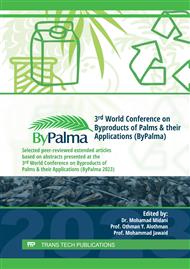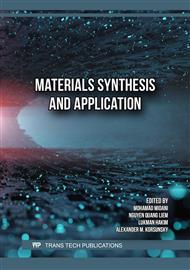[1]
T. Shigemori, M. Okamoto, S. Yamasaki, H. Hayami, Direct melt neutrization and nano-structure of polyethylene monomer-based nano-composites, Composites: Part A, 39, 1924-1929 (2008)
DOI: 10.1016/j.compositesa.2008.09.003
Google Scholar
[2]
N. Sheng, et. al., "Multiscale micromechanical modeling of polymer/clay nanocomposites and the effective clay particle" polymer 45, 487-506, (2004).
DOI: 10.1016/j.polymer.2003.10.100
Google Scholar
[3]
J. Woe, H. Sue, "Effects of clay orientation and aspect ratio on mechanical behavior of nylon-6 nanocomposite", Polymer 46, 6235-6334, (2005).
DOI: 10.1016/j.polymer.2005.05.094
Google Scholar
[4]
Refat El-Sheikhy, Abdulaziz Alkuraif, Mosleh Al-Shamrani, "Converting polymer wastes to nanocomposites", Vacuum, Vol. 217 (2023).
DOI: 10.1016/j.vacuum.2023.112513
Google Scholar
[5]
Refat El-Sheikhy, Exploring of new natural Saudi Nanoparticles, Nature: Scientific Reports, Vol., 10, pp.1-12, 2020.
Google Scholar
[6]
T. Saito, M. Okamoto, R. Hiroi, M. Yamamoto, T. Shiroi, "Poly (p-phenylenesulfide)-based nano-composite formation: Delamination of organically modified layered filled via solid-state processing"; Polymer, 48, 4143-4151(2007)
DOI: 10.1016/j.polymer.2007.05.014
Google Scholar
[7]
N. Sheng, et. al, " Multiscale micromechanical modeling of polymer/clay nanocomposites and the effective clay particle", Polymer 45 , 487-506, (2004).
DOI: 10.1016/j.polymer.2003.10.100
Google Scholar
[8]
Q. H. Zheng, et. al, " Clay –based polymer nanocomposites: Research and commercial Development", Journal of nanoscience and nanotechnology, Vol. 5, 1574-1592, (2005).
Google Scholar
[9]
Refat El-Sheikhy, "Resisting of environmental pollution diseases", Scientific Reports, Vol., 13, pp.1-27, 2023.
Google Scholar
[10]
Sheng, et. al., "Multiscale micromechanical modeling of polymer/clay nanocomposites and the effective clay particle" polymer 45, 487-506, (2004).
DOI: 10.1016/j.polymer.2003.10.100
Google Scholar
[11]
K. Nogi, et. al, " Handbook of nanoparticles", JWRI, Osaka Univ., Osaka, Japan, (2007).
Google Scholar
[12]
Q. H. Zheng, et. al, " Clay –based polymer nanocomposites: Research and commercial Development", Journal of nanoscience and nanotechnology, Vol. 5, 1574-1592, 82005).
Google Scholar
[13]
El-Sheikhy, R.., Al-Shamrani M. Interfacial bond Assessment of Clay-Polyolefin Nanocomposites (CPNC). J Advanced Powder Technology APT. 28, 983-992 (2017)
DOI: 10.1016/j.apt.2017.01.002
Google Scholar
[14]
H. Zhang, et. al. "Fracture behavior of in situ Silica nanoparticle-filled epoxy at different temperature", Polymer 49, 3816-3825, (2008).
DOI: 10.1016/j.polymer.2008.06.040
Google Scholar
[15]
X. F. Yao, D. Zhou, H. Y. Yeh, "Macro/microscopic fracture characterizations of SiO2/epoxy nanocomposites", aerospace science and technology 12, 223- 230, (2008).
DOI: 10.1016/j.ast.2007.03.005
Google Scholar
[16]
Z. Wang, et. al., "Fabrication and mechanical properties of exfoliated clay-CNTs /epoxy nanocomposites", Materials science and engineering A 490, 481-487, (2008).
DOI: 10.1016/j.msea.2008.01.040
Google Scholar
[17]
R. El-Sheikhy, A new treatment of fracture in uniaxial fields, 5th Int. Conf. on multiaxial Fatigue and Fracture, Cracow, Poland, 1997, pp.657-672.20.
Google Scholar
[18]
R. El-Sheikhy and M. Al-Shamrani, on the processing and properties of clay/polymer nanocomposites, Lat. Am. j. solids struct. vol.12 no.2, 2015.
DOI: 10.1590/1679-78251399
Google Scholar
[19]
ASTM D638, for tensile strength testing.
Google Scholar
[20]
ASTM D 5045, for fracture toughness testing.
Google Scholar
[21]
R. El-Sheikhy, N. Nishimura, Comparison among directional fracture theories, Journal of Osaka university scientific reports, Vol. pp. ,(1999)
Google Scholar
[22]
Lee JJW, et. al., Properties ofTooth Enamel in Great Apes. Acta biomater. (2010) 6:4560-4565.
Google Scholar
[23]
Meckel AH, Griebstein WJ, Neal RJ (1965) Structure of Mature Human Dental Enamelas Observed by Electron Microscopy. Arch. oral biol. 10:775-783. Epub 1965/09/01.
DOI: 10.1016/0003-9969(65)90131-7
Google Scholar
[24]
Xu HH, et al. (1998), Indentation Damage and Mechanical Properties of Human Enamel and Dentin. J. dent.res. 77: 472-480. Epub 1998/03/13.
DOI: 10.1177/00220345980770030601
Google Scholar
[25]
He LH, Swain MV (2008) Understanding the Mechanical Behaviour of Human Enamelfrom its Structural and Compositional Characteristics. J. mech. behav. biomed. mater.1:18-29. Epub 2008/01/01.
Google Scholar
[26]
Deng Y, Lawn BR, Lloyd IK, Characterization of Damage Modes in Dental Ceramic Bilayer Structures. J. biomed. mater. res. (2002) 63:137-145.
DOI: 10.1002/jbm.10091
Google Scholar
[27]
Fradeani M, Aquilano A, Clinical Experience with Empress Crowns. Inter. j.prosthet. 10:241-247, (1997)
Google Scholar
[28]
Rhee YW, et. al., Brittle Fracture versus Quasi Plasticity in Ceramics: A Simple Predictive Index. J. amer. cer. soc. (2001) 84:561-565.
DOI: 10.1111/j.1151-2916.2001.tb00698.x
Google Scholar
[29]
MATSUZAKI, et. al., Translucency and flexural strength of monolithic translucent zirconia and porcelain-layered zirconia, Fumiyori, Dental Materials Journal 2015; 34(6): 910–917
DOI: 10.4012/dmj.2015-107
Google Scholar
[30]
Yoshiki ISHIDA and Taira MIYASAKA, Dimensional accuracy of dental casting patterns created by 3D printers, Dental Materials Journal 2016; 35(2): 250–256
DOI: 10.4012/dmj.2015-278
Google Scholar
[31]
Akimasa TSUJIMOTO, et. al., Mechanical properties, volumetric shrinkage and depth of cure of short fiber reinforced resin composite, Dental Materials Journal 2016; 35(3): 418–424
DOI: 10.4012/dmj.2015-280
Google Scholar
[32]
Lawn BR, et. al., Predicting Failure in MammalianEnamel. J. mech. behav. biomed. mater., (2009) 2:33-42
Google Scholar



